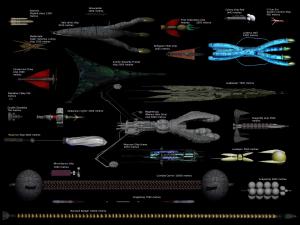BY LETTER
Diademata, The
Technology > Application > Transportation > Ships > Classic Ships
Culture and Society > Cultural Factors > Interstellar Colonization
Galactography > Regions of Space > Periphery
Sophonts > Modosophonts > Sophont Ships
Culture and Society > Cultural Factors > Interstellar Colonization
Galactography > Regions of Space > Periphery
Sophonts > Modosophonts > Sophont Ships
Halo drive Colony ship, launched from Corona in 9255 | |
 Image from Steve Bowers | |
| The Diademata leaves Corona for the Periphery | |
According to local reports, the NoCoZo archailect with responsibility for the Corona Sector gifted the Diademata to the S:2 transapient known as Lán Cǎihé in the early ninety-third century specifically for the purpose of colonisation. For reasons that are not clear, this sector launched several dozen such colonisation missions during this period, settling numerous worlds in the Auriga Periphery.
The Diademata is a Class I Halo-Drive reactionless vessel, capable of a cruising speed of 0.84c, although it can reach greater velocities for short periods, which involves a significant risk of damage from the interstellar medium. The ship has a length of seventeen hundred metres, and can change shape and separate into segments when necessary, allowing it to pass through a 30 metre wormhole.
Lán Cǎihé issued invitations on Corona for volunteers to establish new worlds beyond the reach of the Wormhole Nexus, which at that time stretched 3500 light years from Corona in the Auriga direction, almost directly to rimward. Several diverse groups of settlers came forward, mostly nearbaseline humans and provolved mammals, as well as a number of low-temperature tweaks from the outer Iota Piscium system.
Each group of volunteers was uploaded and stored in the Diademata's databanks for the journey. The first part of the voyage took place within the Nexus, passing via wormhole trunk routes to JD 44-0091005, the most distant wormhole with a large enough throat to admit this vessel. This journey through the Nexus took fourteen years of ship time; the ship could have achieved this in a fraction of that time but the transapient had several social calls to make.
Once outside the Nexus region the Diademata proceeded to its first destination, YTS 5010-910-018, an uninhabited star 4010 ly from Sol, which it reached after a journey of 610 years (measured in the frame of reference of the departure system).
 Image from Steve Bowers | |
| The Diademata deposits a bootstrap package on the planet Myrtilus, YTS 5010-910-018 b | |
Since 9885 this ship has deposited colony packages on at least forty-five worlds, each package containing the uploaded personalities of several hundred colonists plus self-replicating technology that will construct infrastructure to support them once they have downloaded into newly constructed bodies. In at least one case (the Te Kohi system) the uploaded colonists have declined to download themselves and have remained in a virtual state, inhabiting simulated environments.
Once the bootstrap package has been deposited the Diademata moves on (in most cases without actually landing). The colonists are left without transapient oversight from that point, and are free to develop their own culture — a strategy that has been followed innumerable times in the Periphery, although the most successful colonies are generally connected to the Wormhole Nexus eventually. None of the colonies deposited by the Diademata have been connected in this way yet.
Among the new colonies that have so far made contact with the Nexus receiver stations are Utmig, an icy world inhabited by Methanoid tweaks; Safari, a lifeless Gaian which is being terraformed rapidly; Rita II, a gas giant with numerous paraterraformed moons; Myrtilus, an Arean world that is developing a new strain of anarcholibertarian society; Barbarussa, a pig provolve world, and the Effrionzi system, which has apparently suffered a number of local conflicts and which may no longer be inhabited.
Related Articles
Appears in Topics
Development Notes
Text by Steve Bowers
Initially published on 05 September 2013.
Initially published on 05 September 2013.







